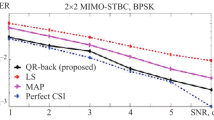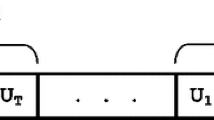Abstract
This paper sets out a modification of algorithms for calculating the QR decomposition and the singular value decomposition of a polynomial matrix into matrices with elements in the form of rational functions, which is equivalent to the use of IIR rather than FIR filters in processing and generating the signal. The proposed approach can reduce the cost of calculating the decomposition and of further signal processing, primarily by reducing the degree of the polynomials which form the elements of the resultant matrix. This is equivalent to reducing the memory interval of virtual subchannels. This method is based on the polynomial version of the QR algorithm and on Bauer factorization.


Similar content being viewed by others
Explore related subjects
Discover the latest articles, news and stories from top researchers in related subjects.References
Aruna, T., & Suganthi, M. (2012). Variable power adaptive MIMO OFDM system under imperfect CSI for mobile ad hoc networks. Telecommunication Systems, 50(1), 47–53.
Angélico, B. A., Burt, P. M. S., Jeszensky, P. J. E., Hodgkiss, W. S., & Abrão, T. (2011). Performance analysis of a single-user MISO ultra-wideband time reversal system with DFE. Telecommunication Systems, 46(4), 333–342.
Hussain, S., Azim, A., & Park, J. H. (2009). Energy efficient virtual MIMO communication for wireless sensor networks. Telecommunication Systems, 42(1–2), 139–149.
Jafari, A., & Mohammadi, A. (2009). A cross layer approach based on queuing and adaptive modulation for MIMO systems. Telecommunication Systems, 42(1–2), 85–96.
McWhirter, J. G., Baxter, P. D., Cooper, T., Redif, S., & Foster, J. (2007). An EVD algorithm for para-Hermitian polynomial matrices. IEEE Transactions on Signal Processing, 55(5), 2158–2169.
Foster, J., McWhirter, J. G., & Chambers, J. (2007). A polynomial matrix QR decomposition with application to MIMO channel equalisation. In Proceedings of 41st Asilomar Conference on Signals, Systems and Computers.
Wirski, R., & Wawryn, K. (2009). QR decomposition of rational matrix functions. In Information, Communications and Signal Processing, 2009. ICICS 2009. 7th International Conference (pp. 1–4).
Foster, J., McWhirter, J. G., & Chambers, J. (2006). Limiting the order of polynomial matrices within the SBR2 algorithm. In IMA International Conference on Mathematics in Signal Processing, Cirencester
Sayed, A. H., & Kailath, T. (2001). A survey of spectral factorization methods. Numerical Linear Algebra with Applications, 8, 467–496.
Author information
Authors and Affiliations
Corresponding author
Rights and permissions
About this article
Cite this article
Dvorakova, I.O., Makovy, V.A., Malyutin, A.A. et al. Matrix decompositions for signal processing of MIMO channels with ISI. Telecommun Syst 59, 463–468 (2015). https://doi.org/10.1007/s11235-014-9906-3
Published:
Issue Date:
DOI: https://doi.org/10.1007/s11235-014-9906-3




